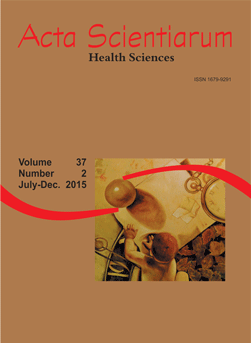<b>Adductor pollicis muscle: potential anthropometric parameter in hospitalized individuals
Resumo
This study evaluated the measurement of adductor pollicis muscle thickness as a parameter for the assessment of nutritional status in patients admitted to a University Hospital in Campo Grande, Mato Grosso do Sul State. This is a prospective cross-sectional study with 64 adults and elderly patients. We evaluated the percentage of weight loss based on the usual weight, arm circumference, triceps skinfold thickness, arm muscle circumference, laboratory parameters and measurement of adductor pollicis muscle thickness. The measurements were performed only once, in the first 72 hours of hospitalization. Data were analyzed using statistical software BioEstat 5.0, with a significance level of 0.05. The average thickness of the adductor pollicis muscle was 17.5 + 5.3 mm. We found a significant negative association of muscle with age. There was a significant association between the measure of muscle and parameters such as body mass index, arm circumference, arm muscle circumference, albumin and nutritional status assessed by physical examination. The adductor pollicis muscle allows easy measurement, direct assessment, fast results, low cost and good correlation with anthropometric parameters. However, further studies should be conducted to validate this new method.
Downloads
DECLARAÇÃO DE ORIGINALIDADE E DIREITOS AUTORAIS
Declaro que o presente artigo é original, não tendo sido submetido à publicação em qualquer outro periódico nacional ou internacional, quer seja em parte ou em sua totalidade.
Os direitos autorais pertencem exclusivamente aos autores. Os direitos de licenciamento utilizados pelo periódico é a licença Creative Commons Attribution 4.0 (CC BY 4.0): são permitidos o acompartilhamento (cópia e distribuição do material em qualqer meio ou formato) e adaptação (remix, transformação e criação de material a partir do conteúdo assim licenciado para quaisquer fins, inclusive comerciais.
Recomenda-se a leitura desse link para maiores informações sobre o tema: fornecimento de créditos e referências de forma correta, entre outros detalhes cruciais para uso adequado do material licenciado.























5.png)







